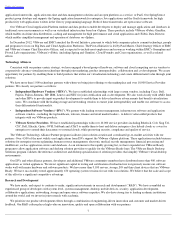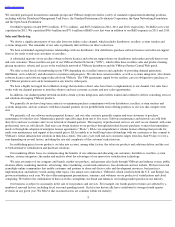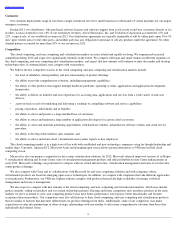VMware 2012 Annual Report Download - page 19
Download and view the complete annual report
Please find page 19 of the 2012 VMware annual report below. You can navigate through the pages in the report by either clicking on the pages listed below, or by using the keyword search tool below to find specific information within the annual report.
Table of Contents
can cause revenue recognition of certain orders to be deferred until future products to which customers are entitled become available;
Our current research and development efforts may not produce significant revenues for several years, if at all.
Developing our products is expensive. Our investment in research and development may not result in marketable products or may result in
products that take longer to generate revenues, or may generate less revenues, than we anticipate. Our research and development expenses were
over 20% of our total revenues in 2012 and 2011. Our future plans include significant investments in software research and development and
related product opportunities. We believe that we must continue to dedicate a significant amount of resources to our research and development
efforts to maintain our competitive position. However, we may not receive significant revenues from these investments for several years, if at all.
We rely upon a two-tier selling strategy, which may not succeed in driving long-term sales and revenue growth.
We sell our products and services through two primary means, which we refer to as our ELA and our non-ELA, or transactional, sales.
ELAs are comprehensive long-term license agreements that provide for multi-year maintenance and support and constitute one-quarter to
one-
third of our overall sales. These are generally larger size transactions, typically driven by our direct sales force and are primarily attractive to
our larger enterprise customers.
Transactional sales, in contrast, tend to be smaller in scope, shorter in duration with a standard one-year maintenance term, and are
principally driven by our sales channel partners. They represent two-thirds to three-quarters of our overall sales.
During 2012, we expanded the sales of product suites, such as our vCloud suite, that integrate advanced management and automation
features with our vSphere cloud infrastructure platform and which are primarily sold through ELAs. We believe that ELAs help us grow our
business by building long-term relationships with our enterprise customers.
In 2012, our overall sales growth rate declined compared to 2011, with the growth rate in transactional sales lower than the growth rate in
ELAs. In 2013, we intend to also focus our selling and marketing efforts to improve the growth rate of our transactional business. As we develop
and add new product capabilities to our higher-end product offerings, our strategy is also to increase the value of the products sold through
the transactional business by enhancing product features and capabilities. We believe that this strategy can increase sales volumes in our
transactional business and help attract new customers to our product ecosystem.
17
•
the sale of our products in the time frames we anticipate, including the number and size of orders in each quarter;
• our ability to develop, introduce and ship in a timely manner new products and product enhancements that meet customer demand,
certification requirements and technical requirements;
•
the introduction of new pricing and packaging models for our product offerings;
•
the timing of the announcement or release of upgrades or new products by us or by our competitors;
•
our ability to maintain scalable internal systems for reporting, order processing, license fulfillment, product delivery, purchasing, billing
and general accounting, among other functions;
•
our ability to control costs, including our operating expenses;
•
changes to our effective tax rate;
•
the increasing scale of our business and its effect on our ability to maintain historical rates of growth;
•
our ability to attract and retain highly skilled employees, particularly those with relevant experience in software development and sales;
•
our ability to conform to emerging industry standards and to technological developments by our competitors and customers;
•
renewal rates and the amounts of the renewals for ELAs as original ELA terms expire;
• the timing and amount of software development costs that may be capitalized beginning when technological feasibility has been
established and ending when the product is available for general release;
• unplanned events that could affect market perception of the quality or cost-
effectiveness of our products and solutions; and
•
the recoverability of benefits from goodwill and acquired intangible assets and the potential impairment of these assets.
























